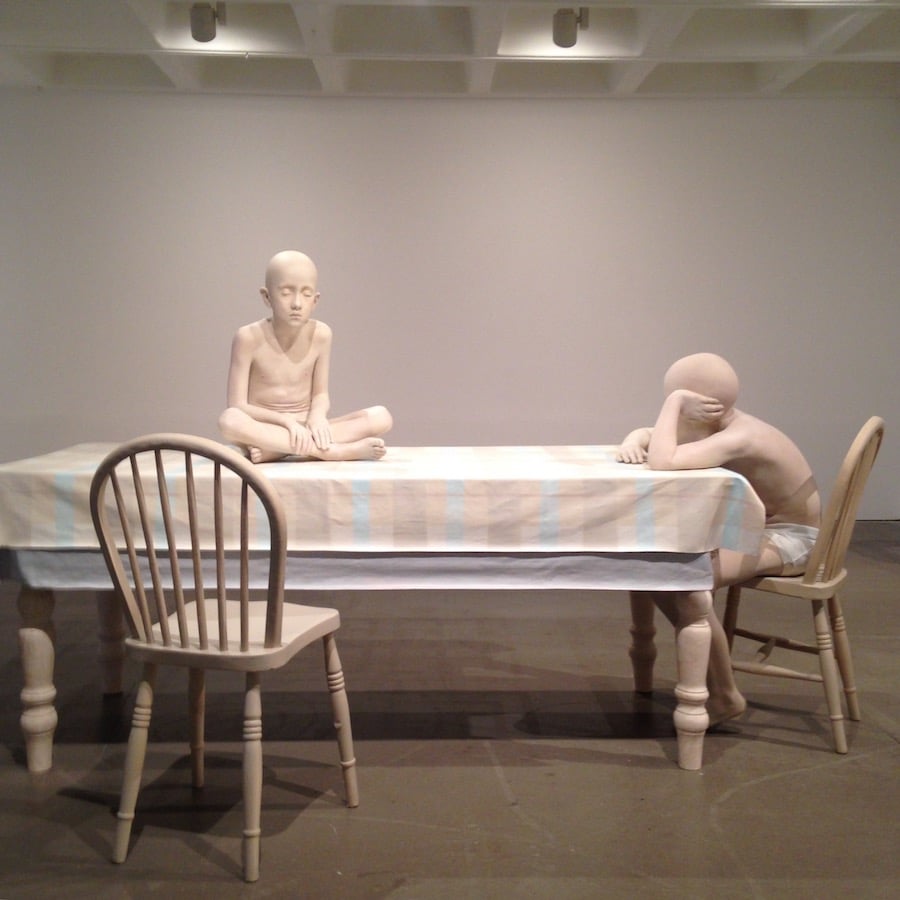
Daphne Wright’s ‘Stallion’
The horse has made many magnificent appearances in art history. Picture the mighty steed carrying Napoleon across the Alps, the thundering brigade in Rosa Bonheur’s Horse Fair (1855), or any of George Stubbs’ marvellous studies. Since their early hour on cave walls at Lascaux, their resolute presence at our side has remained a symbol of strength, power, and above all, status.
None have been quite as antithetical as Daphne Wright’s Stallion (2009). Thrust from the plinth, hooves skyward, this intricately cast marble dust and resin sculpture is worlds away from our typical emblem of grandeur. Fronting the most comprehensive exhibition of Wright’s work to date, the beast that greets us at Arnolfini conveys a controversial relationship we have with our equine friends. Frozen in its ungainly demise, Stallion’s splendour is stripped much as its belly is flayed, provoking an uncomfortable confrontation with reality. Is this what we do with the used, the redundant?
Wright’s diligent creative process is what defines her as an eminent modern artist. Cast from what were once living, breathing creatures, her sculptures—resonantly titled “death masks”—preserve a physical memory of life now past. Once a privilege for mighty men, here the honouring of death results in artwork that straddles the spheres of monument and specimen, akin to Damien Hirst’s infamous tiger shark. On display for our inspection, their detail is morbid yet deeply intriguing.

‘Primate’
Through casting, Wright challenges us with the brutality that brought these beauties before us. The Stallion writhing, a Swan with wings pinned in the air, and a Lamb hung upside down in a bloodcurdling droop that could turn even the most carnivorous stomach. In their presence, we become culprits of crimes committed against nature. Most profound among those dying in vain is Primate, a rhesus macaque euthanized after serving its purpose in research laboratories. Made whilst working with ecclesiastic art conservators, the hand-stitched quilt for fur lays over its delicate body like a shroud, an apology for man’s wrongdoings. Wright brings together science and the spiritual as watercolour eyes of clergymen hover along the wall, watchful but not necessarily condemnatory. The collection exposes our seemingly universal fascination with death, stirring a medley of emotions that relays between blankness, grief, and fear.
The tender treatment of fragility does not halt with animals. In a second room, Wright’s expertise in harnessing material resonance turns to childhood. Unfired Clay Heads moulded by hand with lopsided holes poked in for eyes mimic children’s art so effectively they could belong in a school. At a life-size Kitchen Table, two pallid boys slump, eyes closed, expressionless, and the mundane moment is made strange by their uncanny emotional resignation, as though they have let out a timeworn sigh. There is a palpable malaise about the space, made potent by a recording of boys reciting jokes in deadpan voices no child should sound. Playfulness of clambering on table-tops, of modelling clay, of being a child is shadowed by an uncanny ghostliness. These beacons of innocence age before their time and the tension bleeds into our atmosphere, reeking of vulnerability and abandonment.

‘Kitchen Table’
By combining sound and sculpture, Wright creates sensory experiences reveal another powerful material that she exploits spectacularly: space. Leaving the children we enter a cavernous hall that, filled with towering foil cacti and an equally cavernous voice reading poetry, feels at once scarily endless. In search for security, we slide from here into another domestic interior, one decorated with sculptural Morris-esque wallpaper. Yet on closer inspection we find the vines and roses, which at first seemed comforting, have imprisoned anatomical hearts between their menacing thorns. Whilst the empty hall sucks away our breath as we gaze upwards, the wallpaper assaults us with its close-proximity, amplified by a disembodied voice sharply whispering a cuckoo call seemingly from behind the walls. Expanse or enclosure, we feel no safer in either.
As we spiral through the exhibition, colour—or rather lack thereof—follows us and plays a pivotal role in driving Wright’s message home. White, symbolic of purity and sterility, faith and emptiness, is applied with a deliberate purpose that activates her sculptures by disrupting what would make them recognisably of our world. In the floating eyes, threatening wallpaper, and wraith-like children, a colour that may seem devoid of complexity in fact wriggles with ethereal emotions.
Above all, white signifies absence, an idea anchoring the exhibition that has put Wright on the map as a culturally conscientious modern artist. In a democratic levelling of her subject matter, the artist excavates, with prescience, a growing issue of loss. From life to childhood to safety, losing what we hold dear culminates in a video of an elderly woman struggling to pronounce the alphabet: the ringing white noise of Alzheimer’s hangs in the air, a doleful tune, an awkward song, the sound of life’s vivacity floating away.
Yet, what lingers in every piece is hope. Hope that the stallion will role onto his fine feet; that the boys are only counting to ten; that we are not trapped within the architectures of resignation we create for ourselves. Unearthing every inch of our emotional propensity, Wright shocks us, tickles us, sobers us. The frailty of our existence, she shows, is not something we face in isolation, but profoundly and inextricably a part of who we are together as one people on this tiny planet.
Filed under: Art & Photography

Comments